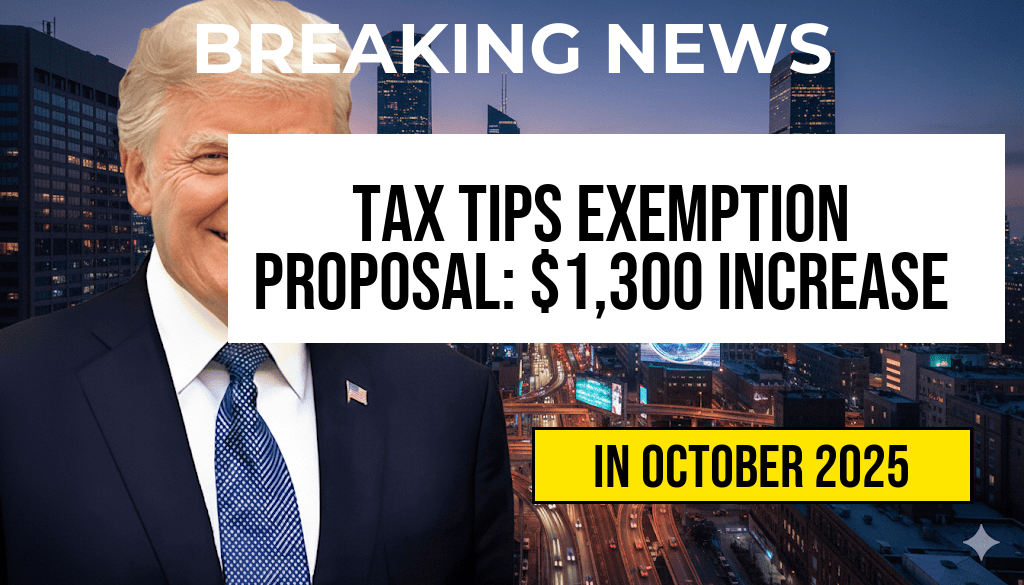Tax Season Update: No Tips Tax Exemption Proposed—Calculate Your Potential $1,300 Increase
A recent proposal from the Internal Revenue Service (IRS) indicates that tips received by workers in service industries will not be exempt from taxation this year, marking a shift from previous considerations. This decision could result in an estimated additional tax burden of up to $1,300 for tipped employees, depending on their income levels and tip amounts. The IRS has emphasized that tips are considered taxable income under federal law, and withholding requirements remain unchanged.
Workers who rely heavily on tips, such as servers, bartenders, and delivery drivers, should prepare for this potential increase in taxable income. The agency’s move aligns with existing regulations but clarifies that no special exemption for tips will be introduced for the upcoming tax season. Experts note that this development underscores the importance of accurate record-keeping and proactive tax planning for service industry employees.
This article details the implications of the IRS’s decision, how to estimate your potential tax impact, and steps to manage your tax obligations effectively during this critical period.
Understanding the Tax Implications of Tips in 2024
Tips have long been considered taxable income by the IRS, requiring employees to report cash and non-cash gratuities. Previously, some advocates argued for a possible exemption or reduction in tax obligations related to tips to ease the financial burden on low-income workers. However, recent announcements clarify that tips will not be exempt from taxation this year, reaffirming existing federal tax policies.
According to the IRS, tips are to be reported by employees and included in their gross income. Employers are responsible for withholding payroll taxes based on reported tip income, and failure to report tips can lead to penalties and audits. The agency also reminds workers that tips received in cash, credit card payments, or through digital platforms are all subject to taxation.
The decision not to exempt tips from taxes could lead to an increase in tax liabilities for many workers, especially those earning the median tip amount. The IRS estimates that the average tipped worker might face an additional $1,300 in taxes annually if their reported tips increase or if they previously underreported their income.
Calculating Your Potential Tax Increase
To understand how this change might impact your finances, consider the following factors:
- Average tip income: The typical tipped worker reports $150–$200 weekly in tips, translating to around $7,800–$10,400 annually.
- Tax rate bracket: Federal income tax rates vary from 10% to 37%, depending on income levels. The additional tip income could push some workers into higher brackets.
- Withholding adjustments: Many employees do not have enough taxes withheld throughout the year, leading to larger tax bills during filing season.
Based on these factors, workers can estimate their additional tax liability using the following simplified example:
| Tip Income | Estimated Additional Tax | Tax Rate Assumed |
|---|---|---|
| $10,000 | $1,300 | 13% |
This calculation assumes a 13% effective tax rate, which is typical for many middle-income earners. Workers earning more or less should adjust their estimates accordingly, possibly consulting tax calculators or financial advisors for precise figures.
Strategies for Tipped Employees to Manage Increased Tax Burden
Given the potential for higher taxes, tipped workers are advised to adopt proactive measures:
- Maintain detailed records: Keep daily logs of tips received, including cash and electronic payments, to ensure accurate reporting.
- Adjust withholding allowances: Submit a new Form W-4 to your employer if you anticipate higher tip income, increasing withholding amounts.
- Save for tax payments: Set aside a portion of tips regularly to cover potential tax liabilities at year-end.
- Consult tax professionals: Seek personalized advice to optimize deductions and plan for the increased tax load.
The IRS also recommends that workers utilize free resources such as the [Taxpayer Assistance Center](https://www.irs.gov/help/taxpayer-assistance-centers) for guidance on reporting tips accurately.
Looking Ahead: Policy Shifts and Industry Impact
While the IRS’s stance remains consistent with existing federal law, advocacy groups continue to lobby for policy changes that could provide relief to low-income workers. Some suggest that establishing a flat exemption or increasing the standard deduction for tipped workers could alleviate the financial strain associated with tip reporting.
Industry analysts note that restaurants and service establishments may also experience shifts in payroll management, as employees adjust to new income reporting requirements. Employers are encouraged to review their payroll systems to ensure compliance and assist workers in accurate tip reporting.
For workers and employers alike, the message is clear: transparency and record-keeping are essential for navigating this tax season effectively. As the IRS emphasizes, understanding your tax obligations now can prevent surprises when it’s time to file.
Resources and Further Reading
Frequently Asked Questions
Question
What is the proposed change regarding tips tax exemption in the upcoming tax season?
Question
How could the proposed tax update impact taxpayers’ financial situation, specifically regarding a potential $1,300 increase?
Question
Who would be affected by the no tips tax exemption proposal, and how might it change their tax liabilities?
Question
How can taxpayers calculate their potential increase in taxes if the tip exemption is removed?
Question
When will the tax season update and the proposed changes be officially announced or implemented?








